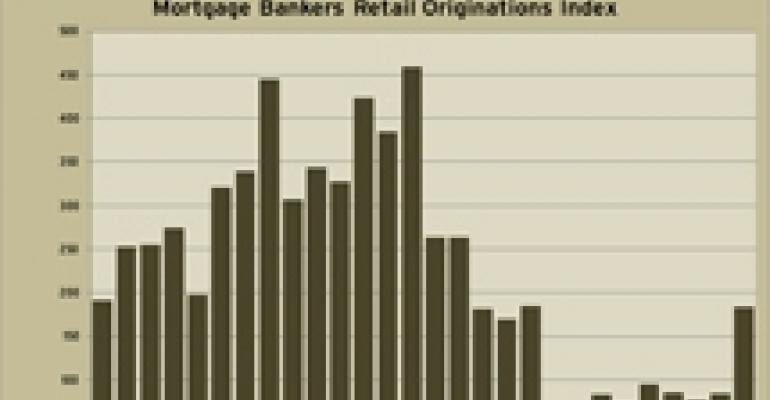The Mortgage Bankers Association’s (MBA) Quarterly Databook showed that the volume of retail loans rose significantly in the fourth quarter of 2010, making it the most active quarter since the third quarter of 2008.
For all property types, the MBA’s originations index reached 114—up significantly from the 70 it posted in the third quarter of 2010 and the highest quarterly reading the association has measured since the third quarter of 2008. It also marks the first time since 2008 that the originations index has exceeded 100—which equates to the volume of an average quarter in 2001.)
The picture was even brighter for retail properties. The MBA’s origination index on retail hit 184 in the quarter—up from a reading of 84 in the third quarter and nearly identical to the third quarter of 2008, when the index came in at 185. The reading broke a string of eight straight quarters during which the retail originations index was less than 100.

When compared to the fourth quarter of 2009, the increase included a 170 percent increase in loans for office properties, a 169 percent increase in loans for hotel properties, a 98 percent increase in loans for industrial properties, a 94 percent increase in loans for retail properties, an 81 percent increase in multifamily property loans, and a 4 percent increase in health care property loans. The resulting origination volume indexes by property type showed health care at the top (301) followed by hotels (198), retail (184), industrial (150), multifamily (138) and office (79).
According to the report: “Commercial and multifamily real estate markets continued to mend in the fourth quarter. Continued stabilization of, and modest improvement in, the U.S. economy continues to filter through to demand for commercial space. The improved property fundamentals are helping buoy sentiment in the market--meaning more sales transactions and improved property pricing. Mortgage originations have increased with the transactions, and the amount of mortgage debt outstanding fell by the smallest amount in a year. The effect of improving property fundamentals and pricing can be seen in mortgage performance, which—for most investor groups—ended the quarter on far more stable footing.”
For the full year, mortgage bankers originated $110 billion of commercial and multifamily mortgages—a 36 percent increase over 2009, according to MBA. Life insurance companies were a leading source of lending in 2010, with origination volumes 155 percent higher than 2009 levels. Fannie Mae, Freddie Mac and FHA/Ginnie Mae also saw strong volumes, with increases in production for FHA/Ginnie Mae offsetting a decline in production for Fannie Mae/Freddie Mac. Originations for commercial banks saw a year-over-year decline, while originations for CMBS conduits increased more than 10-fold.

The level of commercial/multifamily mortgage debt outstanding decreased by 0.5 percent in the fourth quarter to $2.4 trillion—a $12 billion decrease from the third quarter. Commercial banks continue to hold the largest share of outstanding mortgages, at $802 billion. CMBS, CDO and other ABS issues are the second largest at $621 billion.
Among investor types, loans for life insurance companies saw an increase of 112 percent compared to last year’s fourth quarter. There was also a 17 percent increase in loans for commercial bank portfolios, an 82 percent decrease in loans for conduits for CMBS, and the dollar volume of loans for Government Sponsored Enterprises (or GSEs – Fannie Mae and Freddie Mac) saw a decrease of 26 percent.
As for loan sizes, the average retail deal came in at $18.9 million. That is the highest figure in MBA’s data going back to the first quarter of 2004.
The MBA data is the latest sign that commercial real estate more broadly and retail real estate in particular are stabilizing and improving. Investment sales volumes have also risen and vacancy and rental rates have also bottomed or shown slight signs of improvement.

